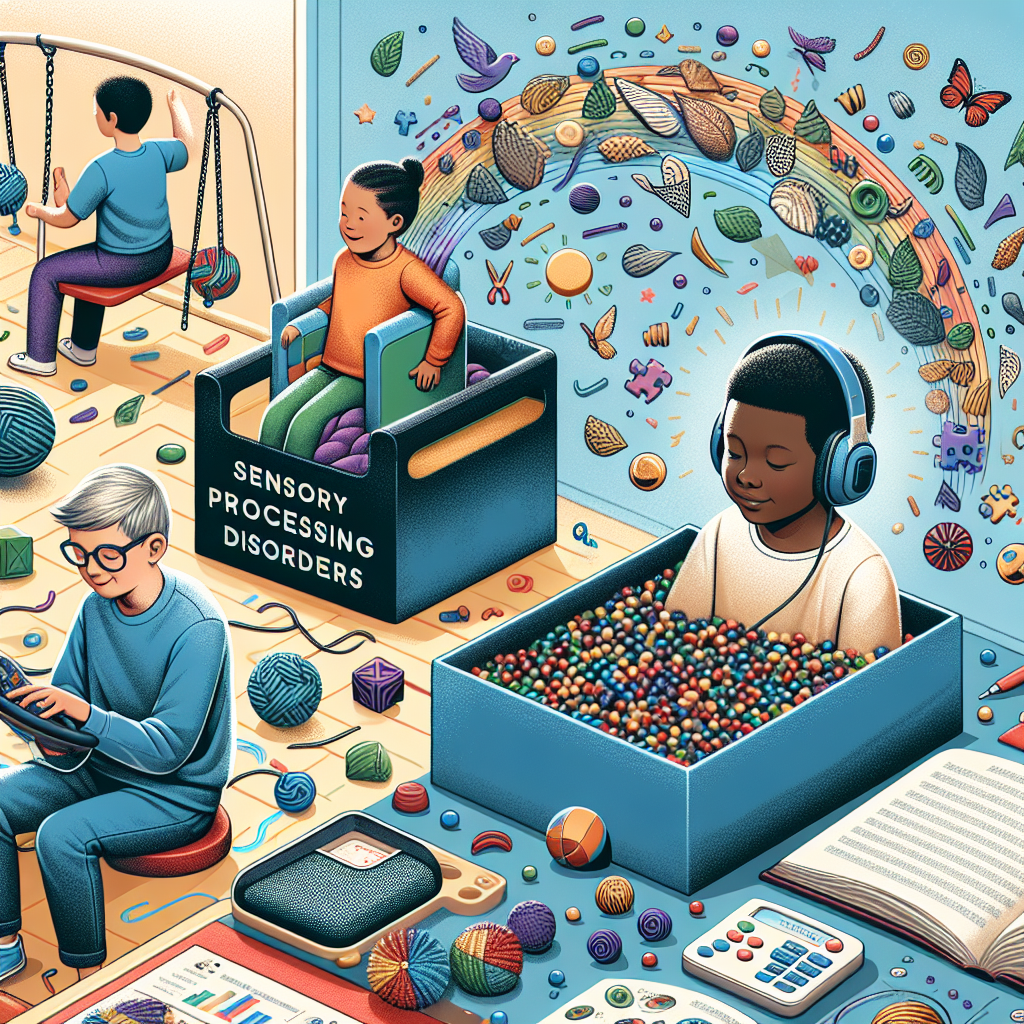
Introduction
Imagine being in a bustling café, where the sound of chatter, the clattering of utensils, and the aroma of freshly brewed coffee swirl around you. For some, this is an inviting atmosphere; for others, it can be a sensory overload, triggering anxiety and discomfort. This disparity in sensory experiences is precisely what sensory processing disorders (SPD) illustrate. SPD affects countless individuals, making it crucial to understand how to recognize the signs and seek appropriate help. In this comprehensive guide, you will delve deep into Sensory Processing Disorders: Recognizing Signs and Seeking Help, equipping yourself with knowledge and strategies to support those in need.
What are Sensory Processing Disorders?
Sensory Processing Disorder (SPD) is a condition that affects how the brain processes sensory information. It can manifest in one or multiple senses, leading to a wide variety of behavioral responses. Some individuals may be hypersensitive (over-responsive) to stimuli, while others may be hyposensitive (under-responsive). Awareness of these disorders is increasing, but many people still grapple with identifying symptoms and finding effective strategies for intervention.
The Sensory Spectrum: Understanding SPD
Sensory processing is about how our brains interpret stimuli from our surroundings, encompassing sight, sound, touch, taste, and smell. Here’s a simplified breakdown of how SPD can affect individuals:
| Sensory Type | Hypersensitivity Signs | Hyposensitivity Signs |
|---|---|---|
| Touch | Avoids certain textures, doesn’t like being touched | Seeks out rough textures, doesn’t notice cuts or injuries |
| Sound | Covers ears in noisy places, gets easily startled | Seems unaware of loud noises, enjoys loud environments |
| Sight | Distracted by bright lights, avoids busy visual stimuli | Drawn to bright colors or flashing lights, seeks visual stimulation |
| Smell | Distressed by strong odors, refuses certain foods | Not bothered by strong smells, enjoys strong-flavored foods |
| Taste | Picky eaters, sensitive to certain food textures | Enjoys strong or spicy flavors, may chew on non-food items |
Case Study: Emma’s Experience with SPD
Emma, a seven-year-old girl, has always been drawn to colorful toys but often screams when her mom brushes her hair. Despite being bright and articulate, she struggles in crowded settings like birthday parties. This led her parents to questions concerning her behavior. After consulting a specialist, Emma was diagnosed with SPD. Her hypersensitivity to touch was the root of her distress. With appropriate therapeutic intervention, Emma gradually learned coping strategies, making social settings enjoyable while also empowering her parents with knowledge to offer support.
Signs of Sensory Processing Disorders
Identifying SPD involves keen observation of behaviors. Here are some notable signs to watch for:
1. Behavioral Signs:
- Increased tantrums or meltdowns
- Unpredictable responses to sensory stimuli (either overstimulation or seeking out stimuli)
2. Developmental Delays:
- Difficulties in motor skills or coordination
- Trouble with self-regulation
3. Social Challenges:
- Difficulty in engaging with peers
- Problems understanding social cues
The Importance of Early Detection
Early recognition of sensory processing disorders is vital to mitigate potential challenges in social interactions and academic settings. Here’s why early detection matters:
| Benefit | Explanation |
|---|---|
| Tailored Intervention | Professionals can design focused therapy strategies. |
| Improved Quality of Life | With coping mechanisms in place, individuals can engage fully in daily life. |
| Enhanced Social Skills | Children can develop appropriate interactions and friendships. |
Seeking Help for Sensory Processing Disorders
Recognizing the signs of SPD is just the first step; seeking professional help is essential for effective intervention.
Types of Professionals to Consult
Occupational Therapists (OTs): Specialize in providing therapeutic interventions tailored to the sensory needs of individuals.
Psychologists/Psychiatrists: Offer counseling and emotional support, which can assist in broader behavioral management.
- Speech Therapists: Can help with social communication challenges stemming from SPD.
Therapeutic Approaches to SPD
When seeking help, various therapeutic approaches may be employed:
1. Sensory Integration Therapy (SIT):
- Facilitates skill development through engaging with sensory activities.
2. Occupational Therapy (OT):
- Focuses on improving daily living skills, fine motor skills, and sensory regulation.
3. Parent Training:
- Equips families with tools to create supportive home environments.
Case Study: Mark’s Journey Towards Healing
Mark, a 10-year-old boy diagnosed with SPD, struggled with extreme reactions to sounds and textures. His parents sought help, beginning with occupational therapy focusing on sensory integration. The therapist introduced Mark to sensory-rich activities like play dough and auditory instruments. Over time, Mark learned to identify and express his feelings concerning sensory overload, drastically improving his communication and adaptability in daily situations.
Common Concerns and Misconceptions
Despite growing awareness, many myths about SPD persist, deterring individuals from seeking help. Here are some common concerns:
1. Myth: SPD is Just a Phase
Many believe that challenges associated with SPD are merely part of childhood. However, SPD is a legitimate diagnosis requiring appropriate interventions.
2. Myth: Only Children Experience SPD
Although commonly diagnosed in children, SPD can affect individuals of any age, including adults facing sensory challenges in work or social environments.
3. Concern: Will Therapy Help?
With the right guidance, many individuals experience improved coping strategies and enhanced quality of life. Early intervention often yields the best results.
Emotional and Practical Support for Individuals with SPD
Alternatively, we can also provide supportive strategies for family members, educators, and peers to foster understanding in those with SPD.
Building a Supportive Environment
Educate Families and Caregivers: Understanding the condition empowers those surrounding SPD individuals to respond appropriately.
Encourage Open Communication: Create a safe space where children can discuss their feelings about sensory experiences.
- Adapt Home/School Environments: Minimize overwhelming stimuli and implement sensory-friendly tools like noise-canceling headphones or textured objects.
Conclusion
Sensory Processing Disorders can be challenging, both for the individual affected and their loved ones. However, understanding the signs and seeking practical help can lead to a more fulfilling and manageable life. By focusing on Sensory Processing Disorders: Recognizing Signs and Seeking Help, you can become an advocate for yourself or others, cultivating environments that embrace sensory uniqueness.
As you embark on this journey of understanding, remember that each individual’s experience with SPD is unique. Stay committed to learning and providing empathetic support, and you’ll foster an environment that honors sensory diversity.
FAQs Regarding Sensory Processing Disorders
Q1: What is the difference between SPD and Autism Spectrum Disorder?
A: While some individuals with autism may show signs of SPD, SPD is distinct. Not all individuals with SPD are autistic, and many autistic individuals may not have SPD.
Q2: How is SPD diagnosed?
A: A team of professionals typically evaluates an individual through observation, questionnaires, and standard assessments to diagnose SPD.
Q3: Can SPD co-occur with other conditions?
A: Yes, SPD can co-occur with conditions like ADHD, learning disabilities, and anxiety disorders.
Q4: What role do parents play in intervention?
A: Parents are critical in implementing strategies at home and advocating for their child’s needs in various environments.
Q5: Are there age limits for intervention?
A: It’s never too late to seek help for SPD. Regardless of age, individuals can benefit from therapeutic approaches tailored to their unique needs.
Remember, understanding is the first step toward healing. With knowledge, we can create a more inclusive world for individuals with sensory processing challenges.















